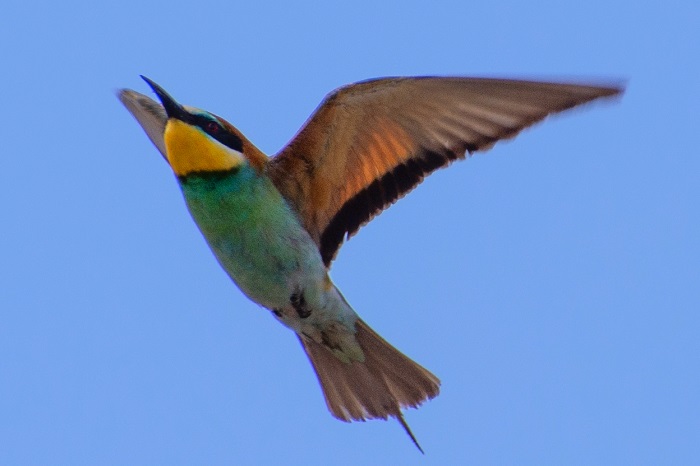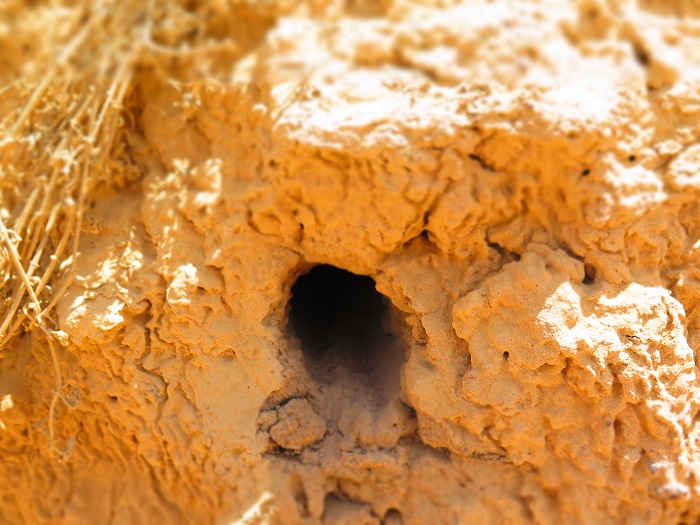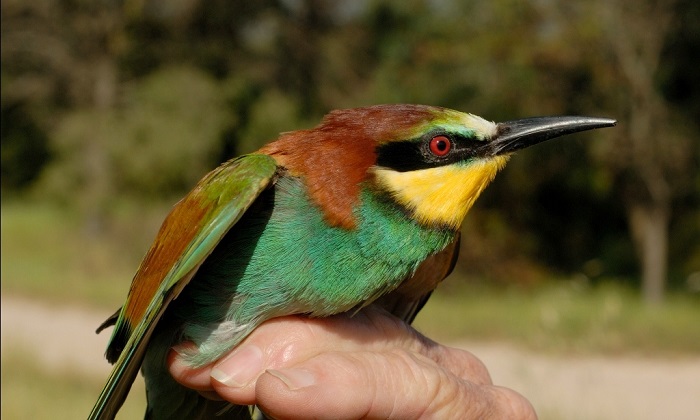Cover image: European Bee-eater by Neels Putter – Thabazimbi district, Limpopo – BirdPix No.153941
Bee-eaters belong to the Family: MEROPIDAE. This family contains three genera and 27 species. Most species are found in Africa and Asia, with a few in southern Europe, Australia, and New Guinea. They are characterised by richly coloured plumage, slender bodies, and usually elongated central tail feathers. All have long decurved bills and medium to long wings, which may be pointed or rounded.
Identification
The European Bee-eater is a large, distinctively plumaged bee-eater. The sexes are similar but females are slightly paler and less colourful than males.

Near Kalbaskraal, Western Cape
Photo by Gerald Wingate
The crown and back are chestnut and the mantle is golden-yellow. The forehead and supercilium are whitish blue, merging into the chestnut crown. The face has a black mask that stretches from the lores to the ear coverts with a narrow, pale blue stripe below. The chin, throat and cheeks are bright yellow. There is a distinct black band on the upper breast that neatly divides the yellow throat from the breast. The breast, belly and vent are entirely rich turquoise blue, fading to whitish-blue on the under tail coverts.

Chimoyo Game Farm, Limpopo
Photo by Vaughan Jessnitz
The underwings are pale rufous with the black-tipped flight feathers forming a conspicuous trailing edge on both the lower and upper wing. The upper wings are green to blue-green with rufous wing coverts. The upper tail is mainly blue-green with the dark-tipped central rectrices that project out into points. The bill is black, moderately long and decurved. The eyes are deep red. Legs and feet are purplish brown.
Local breeding birds are more intensely coloured than Palearctic-breeding migrants, but the two are morphologically indistinguishable.

Brits district, North West
Photo by Andrew keys
Juveniles are similar to the adult female but are duller and greener. They lack central tail streamers and the black breast band is indistinct.
The European Bee-eater is unlikely to be mistaken for another species due to the combination of its yellow throat and black breast-band. Additionally the turquoise underparts, and brown inner wing contrasting with the blue-green outer wing are diagnostic

Nile River, Northern State, Sudan
Photo by Mohamed Salah
Status and Distribution
In southern Africa the European Bee-eater is a Common Palearctic breeding migrant and intra-African breeding migrant.

It is the most widespread of all bee-eater species. The European Bee-eater is largely a Palaearctic species breeding across Europe to central Asia as far as northern India and western Mongolia. Birds on migration occur throughout the Middle-East as well as north and east Africa. The non-breeding grounds are found in west, central and southern Africa.

Vaalkop Dam Nature Reserve, North West
Photo by Lance Robinson
The European Bee-eater is widespread throughout most of southern Africa. It is absent only from the mesic eastern parts of South Africa and the most arid parts of Namibia, Botswana and the Northern Cape. There is an isolated breeding population in southern Africa that breeds in the Western, Eastern and Northern Cape, western Free State and southern Namibia. It is thought that these birds have their non-breeding grounds in tropical Africa.

Thabazimbi district, Limpopo
Photo by Neels Putter
The Palaearctic-breeding population is not threatened. The population that breeds in southern Africa has been estimated to number around 20 000 birds but the current trends in the size of this population are unknown.
Habitat

Ithala Game Reserve, KwaZulu-Natal
Photo by Ryan Tippett
The European Bee-eater occurs in a variety of habitats including woodland, savanna, semi-arid Karoo scrub, fynbos and grassland. It often forages over adjoining freshwater habitats like rivers, marshes and dams. It avoids very arid habitats and also regions with high rainfall.
The population that breeds in southern Africa inhabits the Fynbos, Nama-Karoo and Succulent Karoo biomes.

Carnarvon district, Northern Cape
Photo by Ryan Tippett
Behaviour
The European Bee-eater is highly gregarious at all times and is usually found in loose flocks of 20 to 100 birds. Roosts communally in flocks, usually in leafy trees sleeping shoulder to shoulder.

Near Pilanesberg National Park, North West
Photo by Andre Harmse
The European Bee-eater departs its Eurasian breeding grounds between mid August and early October. They migrate by day in flocks, high in the upper airspace. The first birds arrive in southern Africa from early September, but most arrive in October. They depart north again during late March and early April. Birds that breed in Southern African arrive from central Africa in late August into September, and also depart during March and April.

Groblershoop, Northern Cape
Photo by Les Underhill
European Bee-eaters bathe frequently by dipping the head in water whilst flying, before perching to preen vigorously. Drinks by skimming the water surface like a swallow, or by hovering. The European Bee-eater rests for long periods on prominent perches such as dead tree branches or telephone wires. Flocks spend much time sunbathing and dustbathing. Sunbathing is usually performed socially, on a perch, but occasionally also sunbathes on the ground. Sunbathing is interspersed with preening, scratching and stretching.

Kruger National Park, Limpopo
Photo by Crystelle Wilson
The flight is graceful due to the long wings and tail, allowing for effortless gliding and long swoops broken up by bursts of flapping to maintain momentum. The flight action and speed varies as they dive, twist and turn in pursuit of prey.
European Bee-eaters hunt insects on the wing, either hawking from a perch or in bouts of circling flight, lasting up to 20 minutes or so. Prey is captured up to 150m into the air but sometimes hunts close to the ground, chasing insects disturbed by animals.

Red Sands Country Lodge, Northern Cape
Photo by Dave West
The European Bee-eater consumes a wide array of flying insects including small and large bees and wasps, ant and termite alates, flies, dragonflies, butterflies, moths, bugs, cicadas, water scorpions, mantids, beetles, grasshoppers and locusts.

Faan Meintjies reserve, North West
Photo by Tony Archer
Small non-venomous insects like swarming ants and termites are eaten in flight. Larger insects and those that sting are carried back to a perch in the tip of the bill. Here they are beaten, and rubbed against the perch to remove the sting and venom. The insect is then tossed into the mouth and swallowed.

Middelburg district, Eastern Cape
Photo by Tino Herselman
The European Bee-eater breeds from September to January in southern Africa. They are monogamous, with pair bonds lasting for several years and sometimes even for life. The European Bee-eater is mostly a colonial nester but some pairs also nest solitarily. Each year pairs reoccupying the same regularly used breeding sites. Most colonies in southern Africa number from 10 to 30 active nests. Most nesting sites are in vertical banks, either along dry river courses or in trenches, road cuttings, erosion dongas or sand quarries etc.

Modder River, Western Cape
Photo by Ashwell Glasson
The nest is a tunnel 1.5 to 2m long and is excavated by both sexes. Digging is initially started with the bill, and then later with the feet to clear out excess sand. The tunnel may be horizontal or inclined slightly upwards and ends in an enlarged egg chamber. The eggs are laid on bare soil or on the accumulated remains of insects in tunnels that have been used previously.

Modder River, Western Cape
Photo by Ashwell Glasson
In South Africa clutch size varies from 4 to 6 plain white eggs. European Bee-eaters are single brooded but will replace a clutch in the event of an early failure. They are facultative co-operative breeders with some juveniles or non-breeding adults remaining with the pair as helpers. Further details regarding nesting are a little vague for southern Africa, but can be expected to be similar to data from Europe. The incubation duties are shared by both sexes and lasts for around 20 days. The nestling period lasts for another 31 days and the young are brooded and fed by both sexes or by helpers.

Raptors View Wildlife Estate, Limpopo
Photo by Derek Solomon
Further Resources
This species text is adapted from the first Southern African Bird Atlas Project (SABAP1), 1997.
The use of photographs by Andre Harmse, Andrew Keys, Ashwell Glasson, Crystelle Wilson, Dave West, Derek Solomon, Gerald Wingate, Lance Robinson, Les Underhill, Mohamed Salah, Neels Putter, Tino Herselman, Tony Archer and Vaughan Jessnitz is acknowledged.
Virtual Museum (BirdPix > Search VM > By Scientific or Common Name).
Other common names: Eurasian Bee-eater (Alt. English); Europese byvreter (Afrikaans); Morôkapula (Tswana); Bijeneter (Dutch); Guêpier d’Europe (French); Europäischer Bienenfresser (German); Abelharuco-europeu (Portuguese).
List of species available in this format.
Recommended citation format: Tippett RM 2024. European Bee-eater Merops apiaster. Biodiversity and Development Institute. Available online at https://thebdi.org/2024/07/29/european-bee-eater-merops-apiaster/

Klipheuwel district, Western Cape
Photo by Gerald Wingate

